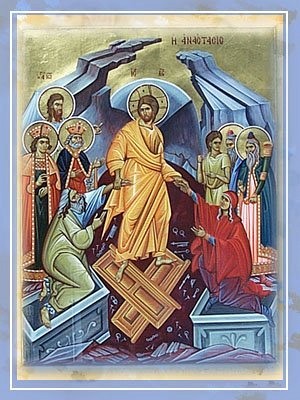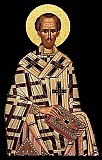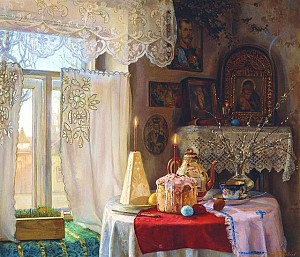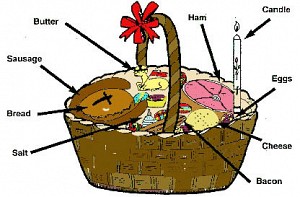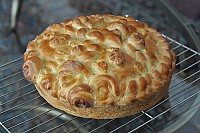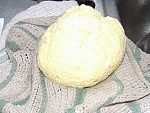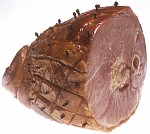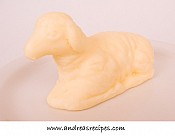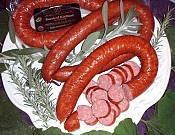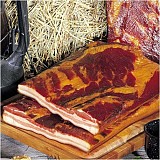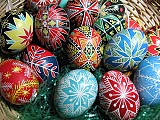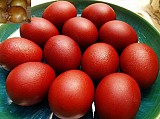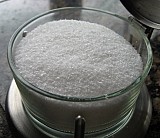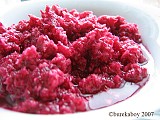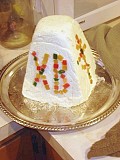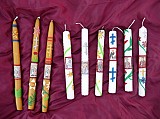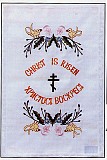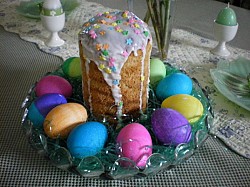|
Christos Anesti! Alithos Anesti!
Christ is risen from the dead, Trampling down death by death, and upon those in the tombs bestowing life! The Paschal Homily of St. John the Chrysostom
When we attend the midnight Resurrection services, (in some places these services do not go through the night but are served up until the end of Paschal Matins and then services are resumed at the Paschal Divine Liturgy the morning of Pascha.) we will hear the famous "Easter Sermon" of St. John Chrysostom. (Literally, "The Golden Tongued" - Zlotoustago in the Russian) This Paschal sermon is read in all Orthodox Churches at Pascha. It speaks to us equally well today as it has to all generations over past centuries. “If any man be devout and love God, let him enjoy this fair and radiant triumphal feast. If any man be a wise servant, let him rejoicing enter into the joy of his Lord. If any have labored long in fasting, let him now receive his recompense. If any have wrought from the first hour, let him today receive his just reward. If any have come at the third hour, let him with thankfulness keep the feast. If any have arrived at the sixth hour, let him have no misgivings; because he shall in nowise be deprived therefore. If any have delayed until the ninth hour, let him draw near, fearing nothing. If any have tarried even until the eleventh hour, let him, also, be not alarmed at his tardiness; for the Lord, who is jealous of his honor, will accept the last even as the first; he gives rest unto him who comes at the eleventh hour, even as unto him who has wrought from the first hour. And he shows mercy upon the last, and cares for the first; and to the one he gives, and upon the other he bestows gifts. And he both accepts the deeds, and welcomes the intention, and honors the acts and praises the offering. Wherefore, enter you all into the joy of your Lord; and receive your reward, both the first, and likewise the second. You rich and poor together, hold high festival. You sober and you heedless, honor the day. Rejoice today, both you who have fasted and you who have disregarded the fast. The table is full-laden; feast ye all sumptuously. The calf is fatted; let no one go hungry away. Enjoy ye all the feast of faith: Receive ye all the riches of loving-kindness. let no one bewail his poverty, for the universal kingdom has been revealed. Let no one weep for his iniquities, for pardon has shown forth from the grave. Let no one fear death, for the Savior's death has set us free. He that was held prisoner of it has annihilated it. By descending into Hell, He made Hell captive. He embittered it when it tasted of His flesh. And Isaiah, foretelling this, did cry: Hell, said he, was embittered, when it encountered Thee in the lower regions. It was embittered, for it was abolished. It was embittered, for it was mocked. It was embittered, for it was slain. It was embittered, for it was overthrown. It was embittered, for it was fettered in chains. It took a body, and met God face to face. It took earth, and encountered Heaven. It took that which was seen, and fell upon the unseen. O Death, where is your sting? O Hell, where is your victory? Christ is risen, and you are overthrown. Christ is risen, and the demons are fallen. Christ is risen, and the angels rejoice. Christ is risen, and life reigns. Christ is risen, and not one dead remains in the grave. For Christ, being risen from the dead, is become the first fruits of those who have fallen asleep. To Him be glory and dominion unto ages of ages. Amen.”
|
Христос Воскресе! Ваистину Воскресе!
PASKA - The Easter Bread (pronounced, paska). CHEESE (Hrudka or Yayechnik, pronounced - hrood-ka or yah-yetch-nick) A custard-type cheese shaped into a ball having a rather bland but sweet taste indicative of the moderation that Christians should have in all things. Also, creamed cheese is placed in a small dish and both are decorated with symbols made of cloves or pepper balls. HAM
(Sunka - pronounced shoon-ka) The flesh meat popular with Slavs as the main
dish because of its richness and symbolic of the great joy and abundance of
Easter. Some may prefer lamb or veal. This is usually well roasted or cooked
as well as other meats prepared in advance so that the festivity of the day
will not be burdened with preparation and all may enjoy the Feast.
EGGS
(Pisanki - pronounced - pi-sun-ki) Hard boiled eggs brightly decorated with
symbols and markings made with beeswax. Indicative of new life and
resurrection. Also we use red eggs traditionally, though this may by some, be considered more of a Greek tradition. In any case, this is America. All traditions are ours!
Pascha (pronounced paska) cheese is classic Easter basket food. Sometimes it's called Russian ice cream because of its smooth, rich texture, but it's really an unbaked cheesecake that is slowly pressed in the fridge for several days to remove excess moisture. It's incredibly rich but also light and refreshing - a creamy dessert with sweet, brandy-spiked cherries, candies, or fresh berries. All of the above articles are placed in a wicker basket and a ribbon or bow is tied to the handle. A decorated candle is placed in the basket and is lit at the time of blessing. A linen cover usually embroidered with a picture of the Risen Christ or symbol with the words "Christ is Risen" is placed over the foods when brought to the church. In some places a large Easter Bread (Paska) is made and brought separately in a large linen cloth. If the origin of the people was from a wine growing region, a sweet wine may be brought.
On Holy
Saturday, Slavic people everywhere will be taking baskets loaded with holiday
foods to church for the traditional Easter blessing, which is a must prior to
eating those exquisite foods.
Neatly arranged in the baskets will be ham, slanina (bacon), chrin (beets with horseradish), salt, paska, kolbasi, hrudka (sirets), butter, pysanky (ornately decorated eggs) for decoration, colored eggs for eating and kolachi. Some people may add candy and a bottle of wine to their baskets. After the foods are placed in the basket, an embroidered cloth cover is placed over them, and a blessed candle is fastened upright near the basket handle. For the first-timers who have never put together an Easter basket, let alone prepared foods for it, the whole process can be mystifying. Every cook has his or her favorite way of preparing these foods and of measuring the ingredients for them, and asking for recipes can result in confusion. To take some of the mystery out of the preparation of the traditional foods, here are a few recipes gleaned from my experience [the author] and a few Slavic cookbooks. This reprint courtesy of the Greek Catholic Union
and first appeared in GCU Messenger, page 12 April 5, 1979 Text by: Rev. Basil Kraynyak Near the end of the Paschal Vigil, after the Prayer Before the Ambo, a single large loaf of bread, the Artos, is brought to the priest. Depicted on the top of the Artos are either the symbol of Christ's victory over death—the Cross, surmounted by a crown of thorns—or the Resurrection of Christ. The Artos symbolizes the physical presence of the resurrected Christ among the disciples. The priest blesses the Artos with a special prayer and sprinkles it with Holy Water. The Artos is then placed on a small table before the Iconostasis where it remains throughout Bright Week. It is customary, whenever the faithful enter the Temple, for them to kiss the Artos as a way of greeting the Risen Christ. On every day of Bright Week, after the Paschal Divine Liturgy (or, alternately, after Paschal Matins), the Artos is carried in a solemn Crucession around the outside of the church. In monasteries, the Artos is carried to the Trapeza every day of Bright Week, where at the end of the festive meal, it is lifted in a ceremony called the Lifting of the Artos. The one performing the ceremony will lift up the Artos (symbolizing Christ's Resurrection) and say, "Christ is Risen!" All will respond, "He is truly Riesn!" The celebrant will then make the sign of the Cross with the Artos as he says, "We worship His Resurrection on the third day!" Then two Paschal hymns are sung and everyone comes forward to kiss the Artos and receive the Superior's blessing, as all sing the Paschal troparion many times. On Bright Saturday, after the Divine Liturgy, the priest says another prayer over the Artos and it is then broken and distributed among the whole congregation along with the Prosphora. The significance of the Artos is that it serves to remind all Christians of the events connected with the Resurrection of Our Lord Jesus Christ. While still living on earth, the Lord called Himself the Bread of Life, saying: I am the bread of life; he who comes to Me shall not hunger, and He who believes in Me shall never thirst (John 6:35). After His Resurrection, more than once Jesus appeared to His disciples, ate before them and blessed their own food. For example, as evening fell on the first day of His Resurrection, He was recognized in Emmaus by two of His disciples as He blessed and broke bread (Luke 24:13-35). On the 40th day after His Resurrection, the Lord ascended into heaven, and His disciples and followers found comfort in their memories of the Lord: they recalled His every word, His every step and His every action. When they met for common prayer, they would partake of the Body and Blood of Christ, remembering the Last Supper. When they sat down to an ordinary meal, they would leave a place at the head of the table empty for the invisibly present Lord and would lay bread on that place. Remembering this custom of the Apostles, the Fathers of the Church made it their custom to put out the Artos at the Paschal Feast in memory of the appearances of the Risen Lord to His disciples, and also in memory of the fact that the Lord Who suffered and was resurrected for our justification has made Himself the true Bread of Life and is invisibly present in His church always, to the close of the age (Mattew 28:20). Whereas special Paschal breads, called kulichi are broken and eaten on the first day of Pascha, the Artos is kept whole throughout the whole of Bright Week as a reminder of the presence of the Risen Savior in the midst of those who believe in Him and is only divided and distributed on Saturday. In this way Bright Week begins and ends with the eating of especially baked and blessed bread. The Artos may also be compared to the unleavened bread of the Old Testament, of which ancient Israel, delivered from their captivity in the land of Egypt, ate during the week of the Passover (Ex. 12:15-20). As Cyril, Bishop of Turov, who lived during the 12th Century in Russia, said in a sermon for the Sunday after Pascha: “Even as the Jews bore the unleavened bread upon their heads out of Egypt through the desert (Exodus 12:34) until they had crossed the Red Sea, after which they dedicated the bread to God, divided it amongst all their host, and having all eaten thereof, became...terrible to their enemies, even so do we, saved by our Resurrected Lord from the captivity of that Pharaoh of the mind, the Devil, bear forth the blessed bread the Artos from the day of the Resurrection of Christ and, finally, having dedicated this bread to God, we eat of it and preserve it to the health of body and soul.” It is a custom among Russian Orthodox Christians to this day to keep a portion of the Artos throughout the year and with due reverence and faith to eat of it in time of illness or distress. This is eaten, often together with a drink of Holy Water, which had been blessed at the Feast of the Theophany of Our Lord. |
 |
|
|||||
| Powered by Orthodox Web Solutions | ||||||
 |
|
|||||
 Diocese of Eastern Pennsylvania
Diocese of Eastern Pennsylvania
 Orthodoxy in America
Orthodoxy in America
